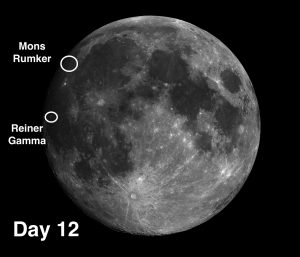 The week of June 25 – July 1 takes us from the end of Day 12, close to full moon, to Day 18. This week we will highlight Mons Rümker, viewable Monday, and the lunar swirl Reiner Gamma viewable all week.
The week of June 25 – July 1 takes us from the end of Day 12, close to full moon, to Day 18. This week we will highlight Mons Rümker, viewable Monday, and the lunar swirl Reiner Gamma viewable all week.
 Mons Rümker: [NW/E4] Unfortunately this feature is too close to the Moon’s limb to see it very clearly, so viewing it must be coordinated with a favorable libration. In spite of its name, Mons Rümker is not really a mountain, it’s an extensive complex of domes. The diameter of the formation is over 40 miles. Although there are about a dozen domes here1, through a telescope it looks like a mound with a bumpy surface. Several of the domes have summit pits. Can you make any of them out?
Mons Rümker: [NW/E4] Unfortunately this feature is too close to the Moon’s limb to see it very clearly, so viewing it must be coordinated with a favorable libration. In spite of its name, Mons Rümker is not really a mountain, it’s an extensive complex of domes. The diameter of the formation is over 40 miles. Although there are about a dozen domes here1, through a telescope it looks like a mound with a bumpy surface. Several of the domes have summit pits. Can you make any of them out?
 Reiner Gamma: [NW/J4] Lunar swirls are absolutely flat features that cast no shadows but leave enigmatic whorl-like markings on the lunar surface. No known geological process could have created them, and to heighten the mystery, instruments on Apollo spacecraft measured strong magnetic fields directly over the swirls. For the fanciful, they are eerily reminiscent of crop circles. Of the three swirls on the Moon, two have been found to be antipodal features of major impact zones and mascons2. All three of the swirls on the Moon (there are two on the far side) are associated with strong magnetic anomalies.
Reiner Gamma: [NW/J4] Lunar swirls are absolutely flat features that cast no shadows but leave enigmatic whorl-like markings on the lunar surface. No known geological process could have created them, and to heighten the mystery, instruments on Apollo spacecraft measured strong magnetic fields directly over the swirls. For the fanciful, they are eerily reminiscent of crop circles. Of the three swirls on the Moon, two have been found to be antipodal features of major impact zones and mascons2. All three of the swirls on the Moon (there are two on the far side) are associated with strong magnetic anomalies.
OF ADDITIONAL INTEREST IN SPACE THE WEEK OF JUNE 25 – July 1:
Full moon will be on Wednesday evening, and although many telescopic sights are washed out during this time, Saturn (which came to opposition earlier on Wednesday) will be only 1° from the Moon and should make a nice pairing. How many of Saturn’s moons can you make out? Jupiter, over the southern horizon, is also a nice object you can view during a full moon.
1 Some sources say 30; how many can you see?
2 mascons: Areas of the Moon’s surface that were discovered to have unusually strong local gravitational effects due to concentrations of dense, thick lunar material [formed from mas(s) + con(centration)]. Mascons are prevalent around lunar swirls.
======================
It is highly recommended that you get a copy of Sky and Telescope’s Field Map of the Moon, the very finest Moon map available for use at the telescope. It is available for $10.95 at www.skyandtelescope.com and on Amazon. All features mentioned in this blog will be keyed to the grid on the Field Map and will look like this: Plato: [NW/D9]
Credits:
Courtesy of Gray Photography of Corpus Christi, Texas
Lunar photos: NASA / USGS / BMDO / LROC / ASU / DLR / LOLA / Moon Globe. Used by permission
- Rupes Cauchy: A Best Known Fault on the Moon - July 22, 2024
- Moon Crater Schickard – Crater Floor has Stripes - July 15, 2024
- Moon Craters Langrenus and Vandelinus - July 8, 2024